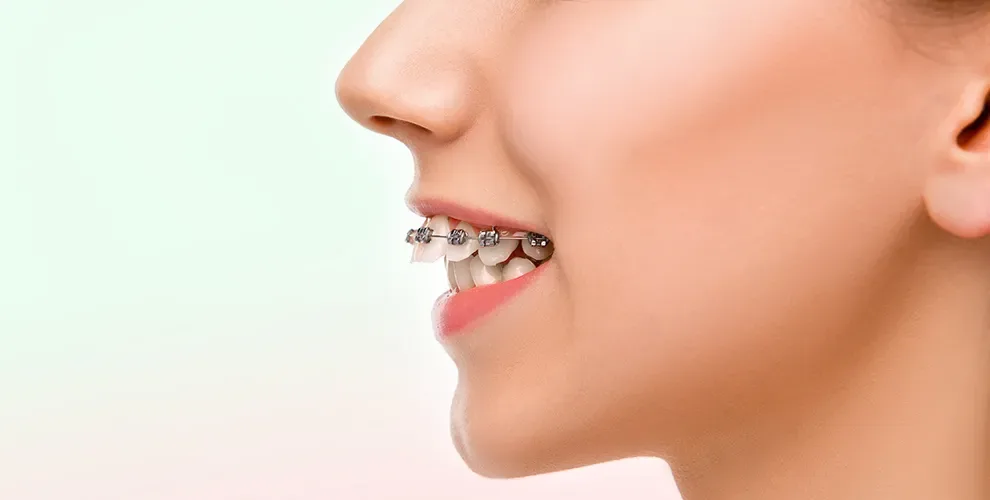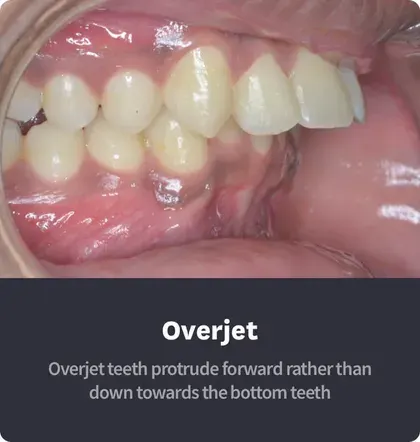Overjet or ‘Protruding’ Teeth - How to Fix

Table of Contents
- What Is an Overjet?
- Key Facts
- What Causes Overjet Teeth?
- How to Fix an Overjet
- Overjet vs. Overbite
- Get the Right Dental Plan
- How Is an Overjet Diagnosed?
- Overjet Prevention
- Overjet FAQs
An overjet refers to a misalignment, or malocclusion, of the teeth in which the upper teeth point outward. This creates a larger distance between the upper and lower front teeth, something that is colloquially known as buck teeth. An overjet is different from an overbite.
Several genetic and environmental factors contribute to these protruding teeth, including skeletal makeup, dental issues such as spacing and crowding, soft tissue conditions such as tongue thrust, lower lip trap and incompetent lips, and personal habits, such as pacifier use and finger or thumb sucking.
You can fix an overjet with orthodontics (braces or aligners), teeth extraction or corrective jaw surgery.
What Is an Overjet?
An overjet is a form of malocclusion, or teeth misalignment.
With overjet, the upper teeth protrude over and outward over the lower teeth. This may be considered a horizontal misalignment. An overjet may be recognizable from an individual’s profile or smile, but doctors use specialized tools to measure the presence and severity of the issue.
How Is an Overjet Diagnosed?
Occlusion, or the relationship between your upper front and lower front teeth when your mouth is closed, is part of a healthy mouth. When your teeth nest together properly, it’s easier to eat without clicking your teeth together and causing more damage. An overjet is a form of malocclusion, or teeth that don’t sit together properly.
To measure an overjet, doctors use a periodontal probe—a metal hook-like tool with measurements notched into it. Doctors push the tip of the probe into the space between your lower teeth and measure the distance between the lower tooth’s front surface and the upper tooth’s back surface.
A measurement larger than 2 to 3 mm is considered an overjet. Bigger measurements mean a greater degree of severity.
Key Facts about Overjet Teeth
Overjet is a form of teeth misalignment in which the upper teeth protrude over the lower teeth and angle outward. It’s also referred to as buck teeth.
Like most types of malocclusion, overjet is most often caused by genetics. Other causes may include childhood oral habits (like extended thumb sucking), gum disease, and jaw disorders.
If left untreated, overjet can increase the risk of tooth damage, decay, and problems eating and chewing.
The options for overjet correction will depend on the severity and cause of the problem. Treatment may include jaw surgery, tooth extraction, and/or tooth replacement in addition to braces or aligners to straighten teeth.
What Causes Overjet Teeth?
One of the leading causes of all malocclusion, including overjet, is genetics. An individual may inherit a “bad bite” or hereditary jaw issue that causes overjet.
Other causes of overjet may include the following:
Common oral habits, like thumb sucking and pacifier use, can affect tooth and jaw development. Don’t let your children use a bottle after 6 months old, and keep your kids from using pacifiers or sucking their thumbs past3 years old.
If you have larger teeth and a smaller jaw, your teeth may become crowded or misaligned. This can cause jaw problems and strain.
If a missing tooth is left untreated, it can result in the teeth shifting and creating misalignment.
Trauma to the mouth or jaw can cause the teeth or jaw to shift, changing how the teeth line up.
If a dental appliance (like a retainer or headgear) or fixture (like a filling or crown) is not fitted properly, it can lead to bad bite patterns and, ultimately, misalignment.
Rarely, tumors of the mouth and jaw can cause malocclusion.
How to Fix an Overjet

You may pursue dental treatment to correct an overjet for these reasons:
You do not like the way your teeth look.
You have trouble biting into certain foods or chewing.
You experience pain or tension in your teeth, gums, jaw, or head.
You have temporomandibular jaw (TMJ) pain.
You have a space of 9 mm or more between the top and bottom incisors.
When you and your dentist work together to create ideal alignment between your top and bottom teeth and correct your overjet, you may need the following treatments. This table can help you understand their differences at a glance:
Method | What Is It? | How Long Does it Take? | Expected Outcomes | Potential Risks |
Doctors numb your mouth, loosen the tooth, and use forceps to remove it. | One-time appointment | With the tooth removed, orthodontists can shift teeth into new positions and reduce gaps. | Infections, swelling, or pain | |
Doctors numb your mouth and implant a screw into the jawbone. A crown attaches to the abutment above the gum line. | Several appointments | If a shifting or missing tooth is causing the overjet, replacing it could be a standalone treatment or part of a longer process of orthodontic care. | Damage to teeth or gums during the procedure, inadequate function, or implant failure | |
Doctors offer anesthesia and surgically amend the size of your jaw or the relationship between your upper and lower teeth. | Several appointments | While it’s rare, overjet caused by birth defects or poorly healed jaw fractures can be treated with surgery. | Pain, infection, and long recovery times | |
Doctors attach brackets to your teeth connected by wires or bands that pull them into alignment. | Several years of appointments | The overjet and other smile problems could be corrected. | Pain, difficulty speaking or eating, and poor oral hygiene | |
Doctors make impressions of your teeth and create a series of clear appliances that slowly pull your teeth into position. | Months of wear | The overjet and other smile problems could be corrected. | Pain and difficulty eating and drinking |
Is an Overjet Like an Overbite?
Overjets and overbites can be easily confused if you have no dental training. Both types of misaligned bites involve front teeth protruding past the bottom teeth, and both can cause jaw misalignment, wear and tear on enamel, and gum disease.
However, teeth that are in an overjet position also protrude forward rather than down toward the bottom teeth. In a review of studies that included people in the U.S., India, Africa, Europe, and China, it was found that around 22 percent of children and adults have an overbite, and about 20 percent have an overjet.
When your upper and lower teeth are in proper alignment, the upper teeth will sit just beyond the lower teeth, by about 2 mm. When the front teeth push out past that, often at an angle, that is an overjet. This poor alignment between the upper and lower incisors specifically is a type of Class 2 malocclusion, according to dentists.
When the top teeth do not properly align with the bottom teeth, they may not meet. This can make biting into food difficult, and you may feel embarrassed when you smile. Overjets may also cause other teeth to misalign, rotate, and shift over time.
Overjet Prevention Plans
Many overjet cases are caused by genetics. If your parents had buck teeth, you’re likely to have them too. But there’s a lot parents can do to help their children grow up with a healthier smile.
To prevent overjet issues in kids, take the following steps:
Ban thumb sucking and pacifiers after age 3.
Switch kids to cups with lids (not bottles) after age 6 months.
Encourage your kids to keep things like pencils or their fingers out of their mouths.
Ask your dentist for help if your children grind their teeth at night.
Adult-onset overjet issues are often caused by injuries or illnesses. If you’re struck in the mouth or face, see your dentist right away for a checkup.
Get the Right Dental Treatment Plan for You
Correcting problems with the alignment of your teeth, like an overjet, is not simply about having a glamorous, Hollywood smile. You may have an overjet and still have the appearance of good teeth alignment.
It is important to listen to your dentist’s recommendations for correcting these problems because you are at greater risk of developing other problems. For example, overjet teeth are more likely to become damaged, chipped, or cracked. One study found that having a large overjet doubles the risk of dental trauma, including damage or tooth loss.
You may have a hard time biting into food and chewing because your teeth do not fit properly together. If your teeth are crowded and that issue caused the overjet, you may have a harder time cleaning all the surfaces of your teeth with brushing and flossing, so you may develop cavities and gum disease more easily.
When you get regular dental checkups, your dentist can discover a forming overjet and help you get the right treatment to stop it. Clear aligners can be a great option for many people.
Overjet Frequently Asked Questions
Most of the time, one of several options will work to correct an overjet. A major overjet can increase the risk of dental damage, jaw pain, speech impediments, and susceptibility to injury.
You can correct overjet through orthodontics, corrective jaw surgery, and tooth replacement or tooth extraction. Orthodontic appliances used to correct overjet include braces, aligners, bonding and crowns.
Corrective jaw surgery is an option for those with a severe overjet coupled with an overbite. Someone with a minor overjet might not need treatment at all, or if they do, they may only need to wear braces or aligners for a brief period.
An overjet is a situation in which the teeth on the upper jaw horizontally overlap the teeth on the lower jaw, resting at a significant outward angle. An overjet is a horizontal tooth misalignment.
An overbite is a condition where the teeth on your upper jaw vertically overlap the teeth on your lower jaw by more than 3 mm. An overbite is vertical tooth misalignment.
Teeth do often shift with age; however, where they move, and how much they move, is unpredictable. An overjet may worsen with age, or it may remain at the same severity.
The risk of complications from an untreated overjet, however, will heighten with age.
Malocclusion, including overjet, can make it harder to clean teeth. Crowding can make it difficult to brush or floss narrow passageways between teeth. These areas can accumulate bacteria and particles that can result in decay and gum inflammation. Spacing and gaps can also become problematic spots.
Overjet can also cause bad bite patterns that result in abrasion between teeth. This can weaken tooth enamel, again increasing the risk of gum problems, including gum disease.
Jaw problems can also result from untreated overjet. This can lead to jaw disorders (including TMJ), headaches, and muscle strain and pain.
Aging means more wear on tooth enamel and jaw muscles, and more time for decay and gum irritation to occur and worsen.
Overjet can’t be corrected without an orthodontic treatment plan. “Natural” treatment options like rubber bands or tongue thrusting are not only not effective, but they can also cause damage to your mouth, teeth, and gums.
The treatment time for overjet will depend on the severity and complexity of the problem and what correction option you’ve chosen for treatment. A mild or moderate case of overjet might be corrected in as little as 4 months with clear teeth aligners, for example. But a severe case of overjet might require jaw surgery and two or more years of braces.
Yes. Clear speech requires an ideal relationship between upper and lower teeth. An overjet means a persistent gap in your jaw, allowing for clicks and whistles to appear and impede your ability to speak clearly.
It depends. Some therapies (like surgery) are considered permanent fixes for jaw problems. Others (like braces) require your ongoing care to ensure your teeth don’t slide back into their old positions.
